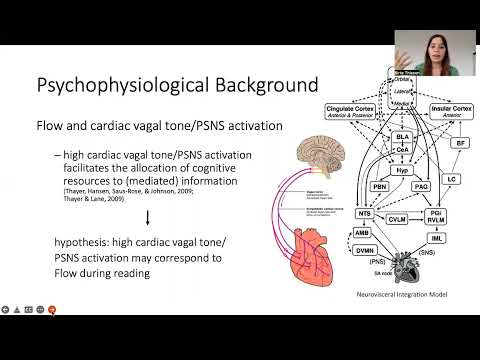 Speaker: Birte Thissen
Speaker: Birte Thissen
 Affiliation: Max Planck Institute for Empirical Aesthetics
Affiliation: Max Planck Institute for Empirical Aesthetics
Title: **At the Heart of Optimal Reading Experiences: Cardiovascular Activity and Flow Experiences in Fiction Reading
Abstract (long version below): This experiment examined the cardiovascular underpinnings of flow experiences during reading, in which the reader becomes completely engaged with the text. A sample of 84 participants read one of three text versions of a chapter of Homer’s Odyssey that differed in terms of readability and thus cognitive challenge. Cardiovascular activity was assessed both prior to and during reading, whereas flow was assessed with a reading-specific self-report scale immediately afterwards. Results of regression analyses suggested that cardiovascular activation patterns that reflect high parasympathetic activity prior to reading serve as a catalyst for flow experiences when a cognitively challenging text is read.**

 Long abstract
Long abstract
Introduction
Fiction reading is a popular leisure activity associated with a variety of pleasurable experiences, including suspense, narrative transportation, and—as indicated by recent empirical studies (Thissen et al., 2018; Thissen et al., 2020) —also flow (Csikszentmihalyi, 1975). Flow experiences generally occur during complete engagement with an activity and emerge from an optimal balance between activity challenges and personal skills (Csikszentmihalyi, 1975; Fong et al., 2015). In the context of fiction reading, flow is theorized to be associated with an optimal balance between text-driven cognitive challenges and the reader’s capabilities in constructing an adequate mental story model from the text (Thissen et al., 2020). Considering that the reader’s inner state may modulate in how far he or she can completely and successfully engage with a text and construct the mental story model, we examined the associations between readers’ cardiovascular measures and the occurrence of flow experiences during reading under varying cognitive challenge conditions. More specifically, we tested whether a cardiovascular activation pattern that is indicative of high activity in the parasympathetic nervous system is associated with flow when reading a cognitively challenging text, since parasympathetic dominance promotes cognitive fluency (Thayer & Lane, 2009; Thayer et al. 2009). Additionally, we tested whether the occurrence of flow in itself leads to changes in cardiovascular activation during reading, meaning that cardiovascular measures could serve as objective markers for readers’ flow experiences.
Methods
Cardiovascular data were collected from 84 participants both during a relaxation baseline prior to reading and during reading. Participants were randomly assigned to read one of three versions of the same chapter from Homer’s The Odyssey. These versions were low, intermediate or high in readability with regard to their writing style, and hence in cognitive challenge posed to the reader. Immediately after reading, flow experiences were measured with the Fiction Reading Flow Scale (FRFS; Thissen et al., 2020).
Conclusion
Regression analyses revealed that cardiovascular activation patterns measured prior to reading that are reflective of parasympathetic dominance – i.e., an inner state associated with cognitive fluency – moderated the occurrence of flow experiences during reading: In line with the idea that flow emerges from an optimal balance between challenges and skills, this cardiovascular pattern supported subsequent flow experiences only in response to the text version of high or intermediate, but not of low cognitive challenge. Changes in cardiovascular activation during reading were, however, not sensitive to our experimental modifications and not predictive of flow experiences. Thus, we found the expected interaction effect between the reader’s inner state and the text’s cognitive challenge level in regard to the occurrence of flow experiences during reading, but did not find changes in cardiovascular activation during reading to mark flow experiences. More specifically, the interaction effect we found suggests that parasympathetic dominance is an inner state that is favorable for the subsequent emergence of flow in cognitively challenging reading situations. Since flow experiences in challenging reading situations could promote important learning opportunities, finding ways to support their emergence constitutes an important future goal for reading research.
References
Csikszentmihalyi, M. (1975). Beyond boredom and anxiety. San Francisco, CA: Jossey-Bass.
Fong, C. J., Zaleski, D. J., & Leach, J. K. (2015). The challenge–skill balance and antecedents of flow: A meta-analytic investigation. The Journal of Positive Psychology, 10(5), 425-446. doi: 10.1080/17439760.2014.967799
Thayer, J. F., Hansen, A. L., Saus-Rose, E., & Johnsen, B. H. (2009). Heart rate variability, prefrontal neural function, and cognitive performance: The neurovisceral integration perspective on self-regulation, adaptation, and health. Annals of Behavioral Medicine, 37(2), 141– 153. doi: 10.1007/s12160-009-9101-z
Thayer, J. F., & Lane, R. D. (2009). Claude Bernard and the heart-brain connection: Further elaboration of a model of neurovisceral integration. Neuroscience & Biobehavioral Reviews, 33(2), 81–88. doi: 10.1016/j.neubiorev.2008.08.004
Thissen, B. A. K., Menninghaus, W., & Schlotz, W. (2018). Measuring optimal reading
experiences: The Reading Flow Short Scale. Frontiers in Psychology, 9, 2542. doi:
10.3389/fpsyg.2018.02542
Thissen, B. A., Menninghaus, W., & Schlotz, W. (2020). The pleasures of reading fiction explained by flow, presence, identification, suspense, and cognitive involvement. Psychology of Aesthetics, Creativity, and the Arts, 15(4), 710–724. doi: 10.1037/aca0000367



 ). Also, we know that the DMN is active in non-flow states, and that the DMN may be important in some aspects of literary reading. (Also, worth remembering that Csikszentmihalyi did not claim that flow is inherently good.) This isn’t intended as a criticism of your paper, which is convincing and interesting in telling us how prior reader states interact with textual properties; instead my comment is intended to ask a question about how the psychology of reading relates to the ethics of reading, which has arisen a few times here.
). Also, we know that the DMN is active in non-flow states, and that the DMN may be important in some aspects of literary reading. (Also, worth remembering that Csikszentmihalyi did not claim that flow is inherently good.) This isn’t intended as a criticism of your paper, which is convincing and interesting in telling us how prior reader states interact with textual properties; instead my comment is intended to ask a question about how the psychology of reading relates to the ethics of reading, which has arisen a few times here.